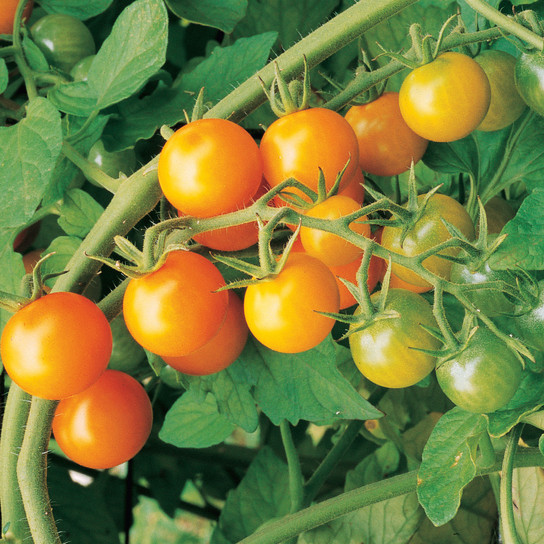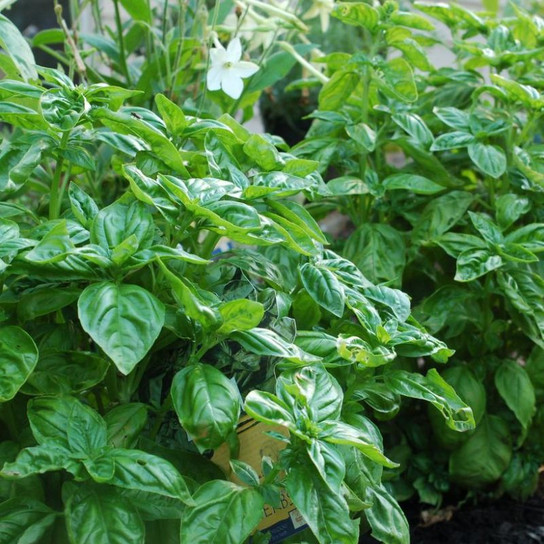
Basil Plants
Uses:
- Herb, Sensory, & Kitchen Gardens
- Containers & Raised Beds
- Indoor Herb Garden
Features:
- Repels Insects
- Zesty Edible Leaves
- Edible Flowers
Sunlight:
- Full Sun
- At Least 6 Hours of Direct Sunlight
Basil is a delicious herb native to Asia. Its vibrant green leaves are highly aromatic and smell of anise. The leaves can be used fresh or dried in cooking and potpourri. This herb blooms at maturity, sending up spikes of pink, purple, or white flowers, which are edible and highly attractive to pollinators. Some gardeners choose to remove the blooms to prevent the leaves from losing their sweetness and flavor. Include a basil plant in your herb or kitchen garden, or grow it indoors on a windowsill for easy harvesting.
About Basil Plants

Genovese Basil, Purple Basil, Saint Joseph's Wort Sweet Basil, Thai Basil
Tropical Africa and Asia
Edible Plants
Herbaceous
8 - 10
Pink, Purple/Lavender, White
Summer
Ascending
Bees, Butterflies, Hummingbirds
Heat, Humidity
Deer, Rabbits
Where To Plant Basil In The Garden
Basil boasts an aromatic, peppery flavor, coming in green to purple leaf varieties for countless culinary adventures. This annual plant thrives in warm climates and can be grown both indoors and outdoors. Its rapid growth and ability to repel certain pests add to its appeal for home gardeners. Chefs appreciate how its leaves add intensity to pesto, salads, and other savory recipes.
These compact plants fit neatly into herb borders or among larger vegetables, provided that their space has sufficient warmth and shelter. In flowerbeds, plant them as accents where brushing by will release their distinctive aroma, or mix them in colorful patio pots for a practical yet eye-catching arrangement. Basil’s neat form and rewarding harvest also enhances a windowsill herb collection. By routinely snipping leaves, you ensure a steady crop through the sunniest months.
Basil Plant Care
Plant basil in late spring, when temperatures remain above 50°F, or 10°C, day and night. Basil thrives in well-draining soil enriched with organic matter. Water the plants enough to keep the soil consistently moist but not waterlogged. Throughout the season, apply gentle liquid fertilizer or compost every couple of weeks to promote leaf development. Ample light—ideally six or more hours of direct sun—plus well-draining soil keeps basil from developing issues like root rot or stunted growth.
To deter early flowering, pinch off top shoots once the plant stands about six inches tall, spurring more side shoots and flavorful leaves. Harvest regularly by clipping stems above a leaf pair, taking care never to remove more than one-third of the total foliage. Keep any harvested sprigs in water at room temperature for short-term storage or freeze chopped leaves in olive oil cubes for longer preservation. In regions with cold nights, basil eventually declines when fall arrives, so plan fresh sowings or keep a few pots indoors to extend the supply.
Learn More About Basil Plants

Growing Basil Plants in Pots
For container culture, choose pots at least eight inches wide, using a fertile, well-draining mix for robust root growth. Place them in a bright, warm spot outdoors or on a windowsill, and water regularly to keep the soil evenly moist. Maintain a consistent light fertilizer schedule to supply nutrients lost through frequent watering. Pinching off leggy stems encourages a fuller canopy and months of wonderfully aromatic leaves.

Basil Companion Plants
Basil thrives beside partners that can handle full sun, porous yet compost-rich soil, steady moisture, and light feedings every week or two. Basil benefits from the shade indeterminate tomato vines cast on summer afternoons, while basil's flowers lure pollinators that keep tomato trusses well set. Tucked between creeping strawberries, basil adds scent that may deter browsing pests and grows well in the same evenly damp soil. Ring the bed with low oregano for an evergreen mulch of flavorful leaves, along with sweet alyssum, whose long bloom draws hoverflies that curb aphids before they reach tender basil tips.














